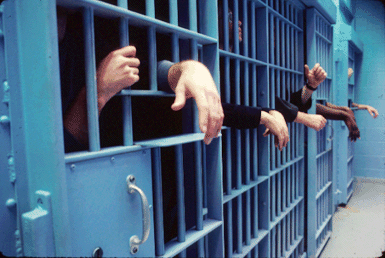Evolution of Corrections: From the Congregate System to the Big House Era and Beyond
 Dr. Michael Beshears, Dr. Michelle Beshears, and Dr. Mark Bond
Dr. Michael Beshears, Dr. Michelle Beshears, and Dr. Mark Bond
- The congregate system ultimately became the model for the American penitentiary, due to financial factors; the short supply of affordable factory labor workers in nineteenth-century America. However, in Europe where factory labor was in great supply during the nineteenth-century; the separate or “solitary” system became the dominant mode for their penitentiaries.
Similarities and Differences
Similarities
| Separate System
Originated in Philadelphia and is sometimes referred to as the Philadelphia or Pennsylvania System. |
Congregate System
First introduced in at Auburn Prison and is often called the Auburn System. |
| Prisoners always kept separate from one another e.g., housed in solitary cells. | Prisoners slept in solitary cells, however, did have limited contact (non-verbal) with other prisoners. |
| The aim of punishment is penance via their lack of freedom and time. Thereby, allowing the prisoner time to reflect upon nature, their misgivings and spiritual matters. (much as the monks of antiquity) | The aim of punishment is penance utilizing monastic features such as solitary cells and silent labor. |
Differences
| Separate System | Congregate System |
| Prisoners were not allowed to ever congregate or to have any contact with each other or the outside world. | Prisoners congregated together for work and meals only. (No speaking allowed) |
| No society per se established due to no contact between prisoners. | A society “without intercourse”, as prisoners may observe each other during meals or labor, however speaking is strictly forbidden. |
| Prisoner labor consisted mostly of craft work. | Prisoner labor consisted of long hours usually performing rote factory labor. |
| Prisoners moved from one location to another by themselves; never as a group i.e., never with other prisoners. | Prisoners often moved from one location to another together in a quasi-military manner (in unison and in lockstep). |
Described life in the Big House
The so-called, Big House is a colloquial term originating in twentieth-century America referring to maximum-security prisons; large centralized prisons constructed during the period of 1900 – 1950). In these facilities, neither penance nor profit was sought after. The prisoner’s living conditions were generally extremely poor. Here a prisoner could expect to receive harsh punishments for minor disciplinary infractions. Nevertheless, there were still significant disparities between the so-called, Big Houses of the northern states as compared to the southern states. The northern state Big House resembled a gutted penitentiary and the southern states Big Houses e.g., Texas, resembled a southern plantation (with its numerous black inmates) or labor-farm, utilizing chain-gang labor and horse-mounted prison guards.
Although the so-called, Big House prison was considered by many to be more comfortable than penitentiaries, cells were cramped and barren. It’s been stated, “If the dominant theme of the penitentiary is terror, the dominant theme of the Big House was boredom”. Whereas, each day a prisoner knew the day would be the same as the day, which preceded it with little or no expectation that any day would ever be different.
Prison populations were racially segregated to the point that minority American prisoners were forced to make their own separate minority inmate society, as a means to their survival. In that minority, prisoners were seemingly invisible to social scientist, as well as to white inmates and prison officials during this period of American history. Female inmates during this period were not as plentiful still segments of male prisons were reserved for women. A female prisoner’s life would most likely be one of extreme abuse and sexual exploitation, as well as rape. Later, as the female prisoner population grew females were moved out of the Big House to other facilities ran utilizing the custodial model. The custodial model was constructed of a regime for men. Therefore, women custodial institutions treated female inmates like men and were for a substantial period of time, ran by men.
How the Big House Differed from the Penitentiaries and Reformatories that Preceded It
Unlike the Big House Era, the penitentiary movement excluded women and minorities. This was because women inmates were too infrequent in the prison population. This, therefore, made it difficult to adequately configure women into the mass programming used for the so-called, penitentiary experiment. Racial minorities, on the other hand, were excluded as they were considered unacceptable for the penitentiary experiment.
The penitentiary experiment more than the Big House Era, in fact closely compared to the reformatory era, especially as compared to the Elmira Reformatory (1870), with the exception of the reformatory’s traditional vocational programming. The congregate system just as Elmira utilized a paramilitary approach; the only difference is that Elmira targeted wayward young men. This approach rendered inappropriately such as was the case with Elmira, proved that such a facility to be a harsh, brutal, punitive penal institution much like; a penitentiary and dissimilar to the Big House in this regard.
The Women’s Reformatories, which lasted roughly between 1860-1935, seemed to at least provide a better model towards useful reform. Its approach was centered towards instruction in the genteel woman’s role. However, unlike the Big House ideology, it did not accept men and minorities were generally excluded, due to their alleged lack of moral development, as well as the belief that black women were too masculine.
Unlike, the Big House the women reformatory buildings were designed more like cottages, each housing approximately 20 inmates where they would reside together with a motherly matron in a familial setting. This is a significant distinction from the use of housing inmates in a cell, as with the Penitentiary or Big House era.
Dr. Beshears has an associate degree in general studies and a dual baccalaureate degree in criminal justice and psychology from Drury University. In addition, he has three graduate degrees, one in criminology from Indiana State University and another in health services management from Webster University. Plus, an additional 18 graduate hours in public administration. His Ph.D. is in business with a specialization in criminal justice from Northcentral University. Dr. Beshears after 22 years of honorable service retired from the United States Army in 1998, at the rank of Master Sergeant. While on active duty he was the Non-commissioned Officer of the Year at 2 different commands and an Army Leadership Academy Honor Graduate. As a civilian, he has worked with the local sheriff’s department, state drug task force and FBI. Dr. Beshears has acquired over 20 years of teaching experience in the traditional and online teaching environment. He has an extensive background and first-hand experience in online andragogy instruction, as one of the first Internet (online) course developers and instructors. Since 1994, he has instructed 10,000+ online and traditional students in criminal justice, corrections, and management. He has mentored numerous colleagues in the skills required to instruct online while promoting student success. Dr. Beshears resides with his wife Dr. Michelle Beshears, their son Hunter, and daughter Malia near Norfork and Bull Shoals Lakes, in Clarkridge, Arkansas. He also has three beautiful grown daughters Michele, Cora, and Mollye.
Dr. Beshears has earned two baccalaureate degrees one in social psychology and another in criminal justice. She also has two graduate degrees one in human resource development and another in criminology from Indiana State University. She has also earned her Ph.D. in Business Administration with a specialization in Criminal Justice from Northcentral University. Dr. Beshears served in the U.S. Army for 11 years. She obtained the rank of Staff Sergeant prior to attending Officer Candidate School at Fort Benning, Georgia where she earned her commission. As a commissioned officer. Dr. Beshears has led numerous criminal investigations and worked with several external agencies as well. As a civilian, she has worked with the local sheriff’s department, state drug task force and FBI. Dr. Beshears resides with her husband Dr. Michael Beshears, their son Hunter, and daughter Malia near Norfork and Bull Shoals Lakes, in Clarkridge, Arkansas. She also has three beautiful grown stepdaughters, Michele, Cora, and Mollye.
Dr. Bond has worked in law enforcement and has been a firearms instructor for more than 33 years. His law enforcement experience includes the military, local, state and federal levels as a police officer and criminal investigator. Mark obtained a BS and MS in criminal justice and M.Ed in educational leadership with Summa Cum Laude honors. As a lifelong learner, he earned his doctoral degree in education (EdD) with a concentration in college teaching and learning. Mark is currently an assistant professor of criminal justice at a university and adjunct professor of administration of justice studies at a community college.




